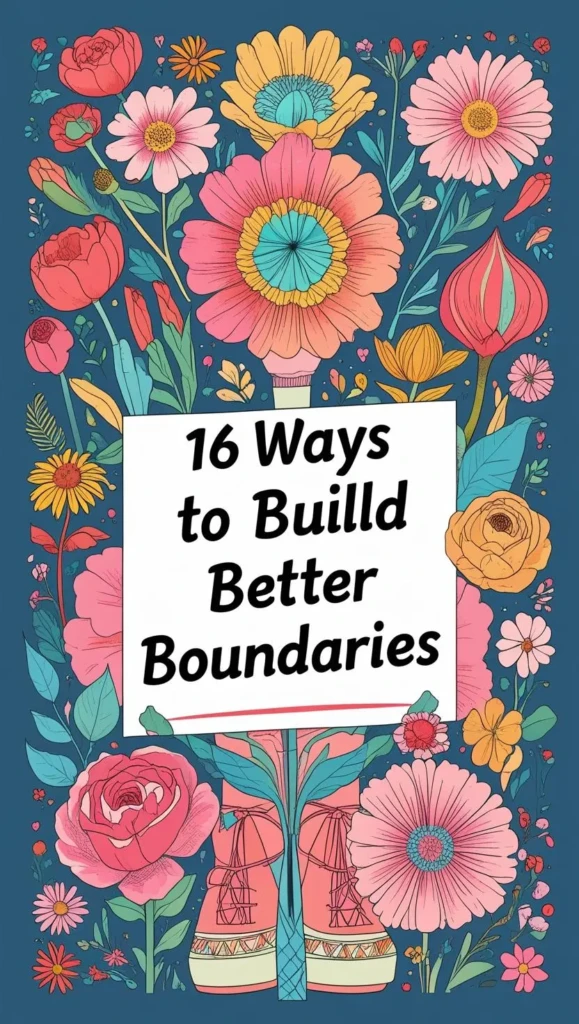
You’ve likely said “yes” to that extra project when you’re already drowning, or let your mom guilt-trip you into Sunday dinner for the third week straight. I used to think boundaries were mean, but here’s the thing – they’re actually the kindest gift you can give yourself and others. After years of being everyone’s doormat and burning out spectacularly, I’ve learned that setting clear limits isn’t selfish. Let me show you exactly how to stop the madness.
Key Takeaways

- Start with 2-3 critical boundaries rather than many at once, focusing on consistency over intensity for maximum impact.
- Block 1-2 hours weekly as non-negotiable personal time and protect this boundary fiercely from others’ demands.
- Address boundary violations immediately using clear, specific language and consistently follow through on stated consequences.
- Use simple responses like “I can’t do that” without elaborate explanations, as over-explaining invites negotiation.
- Check your calendar and energy levels before saying yes to requests, especially when already working 50+ hours weekly.
Reflect on Your Personal Needs and Limits
Anyone who’s ever said “yes” to every request, favor, or last-minute project knows that sinking feeling when you realize you’ve completely overcommitted yourself again.
Here’s the thing: you can’t build effective boundaries without first understanding your personal needs and personal limits. Start by grabbing a journal and getting brutally honest with yourself. What drains your energy? When do you feel most productive? How many hours can you realistically work before burnout kicks in?
I learned this the hard way after saying yes to three weekend projects in one month. Document your work schedule preferences, communication style with supervisors, and energy patterns. This isn’t selfish—it’s strategic intelligence gathering that’ll help you protect what matters most.
Consider using the Eisenhower Matrix to evaluate which requests truly deserve your time and which ones you can decline without guilt.
Start Small With Just a Few Key Boundaries
Once you’ve figured out your personal needs and limits, resist the urge to transform into Boundary Enforcer Supreme overnight. Trust me, I learned this the hard way when I tried setting twelve new boundaries in one week and felt like I was constantly in battle mode.
Start with just two or three critical boundaries that’ll give you the biggest impact. Maybe it’s not checking emails after 7 PM, or saying no to weekend work calls. I began with boundaries around my schedule and communication preferences, then gradually added more over the following months.
This approach works because you’re not overwhelming yourself or others with sudden changes. You’ll actually stick to your boundaries when you’re not juggling ten new rules simultaneously. Give yourself time to master the basics before expanding your boundary-setting empire.
Remember that consistency beats intensity when building new habits, so focus on maintaining your chosen boundaries regularly rather than trying to enforce everything perfectly from day one.
Establish Boundaries Early in Relationships
You know how awkward it feels when you’re three months into a friendship and suddenly need to tell someone they can’t just drop by unannounced at 10 PM? Setting clear expectations right from the start saves you from those uncomfortable conversations later, plus it actually makes relationships smoother because everyone knows where they stand.
I learned this the hard way after spending two years tiptoeing around a roommate who thought my Netflix password was community property, when I could’ve just said “hey, let’s keep our streaming accounts separate” on day one. This approach aligns with the principle of separation of tasks – understanding what responsibilities belong to you versus what belongs to others, which creates healthier relationships and clearer personal boundaries from the beginning.
Setting Early Expectations
When I first started dating my now-husband, I made the mistake of not setting boundaries early on, and let me tell you, it created some awkward conversations three months in when I finally spoke up about needing alone time on Sunday mornings.
Don’t make my rookie error – you need to set your expectations from day one, not after you’re already frustrated. When you communicate your needs upfront, you’re not being demanding; you’re being strategic.
Take control by stating your non-negotiables within the first two weeks. Whether it’s your gym time on Tuesday evenings or your monthly girls’ night, make it clear what matters to you. This approach saves everyone the uncomfortable backpedaling later and establishes your authority in the relationship.
Preventing Future Conflicts
Imagine this scenario: it’s month four of your new relationship, and suddenly you’re having your first real fight because they assumed you’d spend every weekend together, while you thought Tuesday dinners were the extent of your commitment. Sound familiar? This mess could’ve been avoided with upfront boundary conversations.
Setting boundaries early feels awkward, but it’s like wearing a seatbelt – protective and smart. During those first few dates, mention your personal dealbreakers. Maybe you need two nights alone per week, or you don’t share passwords. Whatever it is, speak up before assumptions take root.
I’ve learned that three weeks in is the sweet spot for deeper boundary talks. By then, you’re past surface-level chitchat but haven’t built conflicting expectations yet.
Maintain Consistency in Your Boundary Setting

One wobbly boundary can topple your entire system faster than a house of cards in a windstorm. Trust me, I’ve watched my carefully constructed limits crumble because I gave someone “just this once” leeway on a Tuesday afternoon.
Consistency isn’t just helpful—it’s your secret weapon for commanding respect. When you stay steadfast with your boundaries, people know exactly what to expect from you. No guessing games, no testing the waters.
I learned this the hard way when I let my neighbor borrow my lawnmower “quickly” after saying no to everyone else. Within two weeks, three different people expected the same exception. Your boundaries lose all credibility when they become suggestions rather than rules. Stay firm, stay consistent, and watch your personal power grow exponentially.
Like building any healthy habit, consistent habits create momentum that makes maintaining your boundaries easier over time.
Carve Out Dedicated Time for Yourself
Your calendar probably looks like a Tetris game gone wrong, with every block filled except for basic survival needs like eating and sleeping. You’ve become a master at squeezing meetings into five-minute gaps, but when’s the last time you carved out personal space for yourself?
Here’s your power move: block out 1-2 hours weekly that’s completely yours. Mark it on your calendar like you’d any important meeting, because honestly, it is. Use this time for whatever recharges your time and energy – reading, exercising, or diving into that hobby you’ve been neglecting.
The secret sauce? Protect this boundary fiercely. Tell your family, friends, and coworkers this time is non-negotiable. Consistency transforms this from a nice idea into your weekly lifeline.
Consider starting each dedicated session with a five-minute meditation to create a clear mental transition from your busy schedule into your personal time.
Use Simple and Clear Language When Communicating
Setting aside personal time is just the beginning – now you need to communicate those boundaries without sounding like you’re delivering a dissertation. Clear communication doesn’t require a master’s degree in diplomatic relations. When I tell my coworkers “I’m unavailable after 6pm,” that’s it – no twenty-minute explanation about my evening routine or apologies for having a life outside work.
Your boundaries become effective boundaries when you skip the justifications. Instead of saying “I can’t take on extra projects because I’m already overwhelmed with my current workload and need to maintain work-life balance,” try “I can’t take on additional projects right now.” Period. End of sentence.
Simple language commands respect because it’s confident, direct, and leaves zero room for negotiation or confusion. As Ayn Rand wisely noted, “The question isn’t who is going to let me; it’s who is going to stop me” – and this mindset applies perfectly to boundary setting where your clear communication becomes an unstoppable force.
Set Healthy Boundaries on Social Media

While your offline boundaries might be rock-solid, social media can turn even the most boundary-savvy person into an oversharing, doom-scrolling mess. Those blurred boundaries happen fast when you’re posting vacation pics with your exact location or venting about personal drama for everyone to see.
Your digital boundaries should mirror your real-life ones. If you wouldn’t share something at a dinner party, don’t post it online either.
Here’s how to reclaim your social media power:
- Limit exposure to negative content that drains your energy
- Communicate your posting preferences clearly with friends and family
- Enforce consequences when people repeatedly cross your stated boundaries
- Keep personal information private, even from close connections
Consider doing an energy audit by tracking how different social media activities affect your mental clarity and mood throughout the day.
Protecting your online space isn’t selfish—it’s essential for maintaining your sanity and authentic relationships.
Create Physical Boundaries When Necessary
Sometimes you need to build actual, physical walls between yourself and the chaos around you – and I’m not talking about anything dramatic here.
Whether it’s shutting your office door when you’re trying to focus, or creating a phone-free zone in your bedroom, physical boundaries can work wonders for protecting your mental space.
Think of these barriers as your personal force field, giving you the breathing room you need to recharge, concentrate, or simply exist without constant interruptions.
You might even consider setting up a dedicated wellness space in your home where you can retreat for meditation, stretching, or quiet reflection when you need to reset your boundaries and reconnect with yourself.
Workspace Personal Space Protection
Creating physical boundaries in your workspace isn’t just about having a fancy home office—it’s about protecting your sanity and productivity from the chaos of daily life.
Your workspace deserves fortress-level protection because boundary building requires intentional design. You can’t expect focus when your kitchen table doubles as both conference room and cereal bowl central. Pick one designated area and claim it as yours—even if it’s just a corner with a folding screen.
Here’s how to defend your territory:
- Keep phones and laptops in separate rooms to eliminate scrolling temptations
- Use closed doors as your “do not disturb” signal
- Install physical barriers like screens or partitions for privacy
- Consistently enforce these physical boundaries, even when family members test them
Your productivity depends on these non-negotiable limits.
Home Sanctuary Establishment
After you’ve secured your workspace fortress, it’s time to expand that boundary-building magic to your entire home because your living space should feel like a retreat, not a stress factory. Home sanctuary establishment means creating zones where you control the energy, noise, and interruptions.
| Boundary Type | Implementation Strategy |
|---|---|
| Bedroom | No phones after 9 PM, blackout curtains |
| Living Room | Designated “quiet hours” from 7-9 PM |
| Kitchen | Family meeting space with 30-minute limits |
| Bathroom | Lock the door, enforce knock-first rule |
| Entry Area | Shoes off, coats hung, clutter-free zone |
Set boundaries by establishing these physical rules with everyone in your household. You’ll transform chaotic spaces into peaceful sanctuaries where you can actually recharge instead of feeling drained.
Communicate Directly When Boundaries Are Crossed
Most people freeze up like deer in headlights when someone tramples their carefully set boundaries, but that’s exactly when you need to speak up most. Your boundary isn’t a suggestion—it’s a non-negotiable line that deserves respect. When someone crosses it, you’ve got to communicate directly, not hint around hoping they’ll magically understand.
Your boundaries aren’t requests—they’re requirements. Stop apologizing for enforcing what you need to feel safe and respected.
Here’s your game plan for boundary enforcement:
- Address the violation immediately, not three weeks later when you’re seething
- Use clear, specific language: “You crossed my boundary when you…”
- Explain why this boundary matters to you personally
- Set consequences if the behavior continues
When you affirm “I am worthy of respect and treat others with kindness,” your brain’s respect-detection system naturally establishes reciprocal boundaries that end the exhausting cycle of people-pleasing.
Establish Clear Consequences for Violations
You’ve communicated your boundaries clearly, but what happens when someone decides to test them anyway? That’s where consequences come in – they’re your backup plan that shows you’re serious about protecting your well-being.
Without clear consequences that you actually follow through on, your boundaries become more like gentle suggestions that people can ignore whenever it’s convenient for them.
Smart women understand that setting boundaries isn’t about being selfish, but about being strategic with their energy audits to maximize their capacity for the opportunities that truly matter.
Define Specific Boundary Consequences
Setting consequences for boundary violations felt awkward at first, like I was being overly dramatic or controlling. But Nedra Glover Tawwab taught me that setting healthy boundaries without consequences is like putting up a fence with no gate latch—it looks nice but doesn’t actually protect anything.
You need to define exactly what happens when someone crosses your line. Here’s what worked for me:
- Communication limits: “If you yell at me, I’ll end the conversation and won’t respond to texts for 24 hours”
- Physical boundaries: “Show up unannounced again, and I won’t answer the door”
- Financial consequences: “Borrow money without paying back the previous $50, and I’m done lending”
- Relationship escalation: “Continue this behavior, and we’ll need a two-week break from contact”
Specificity gives you power.
Communicate Consequences Clearly Upfront
Nobody wants to be the person who sounds like they’re reading terms and conditions at a dinner party, but here’s the thing—communicating consequences upfront isn’t about being mean or controlling. Setting healthy boundaries requires clarity, and clarity protects your mental health.
When I started telling people, “If you keep interrupting me during meetings, I’ll stop sharing my ideas with the team,” suddenly they listened. You’re not threatening anyone—you’re giving them a roadmap to respect you. Think of it like posting speed limit signs before issuing tickets.
Give specific timeframes too. “If you’re more than 15 minutes late without calling, I’ll leave” works better than vague warnings. Clear communication empowers everyone involved.
Follow Through Consistently
After you’ve laid out your boundaries like a GPS route, the real test begins—actually following through when someone takes a wrong turn. This is where most people crumble because they feel guilty or selfish. But here’s the truth: consistent enforcement isn’t mean, it’s necessary. When you respect others enough to be clear about your limits, you also need to respect yourself enough to uphold them.
Your follow-through plan should include:
- Stop responding immediately when boundaries are crossed—silence speaks volumes
- Remove yourself from situations where limits aren’t respected
- Limit contact with repeat offenders for specific timeframes
- Have backup consequences ready for persistent boundary pushers
Consistency shows you’re serious about your well-being, not just making empty threats.
Practice Saying No Without Over-Explaining

One of the hardest lessons I learned about boundaries came when I realized I was giving mini dissertations every time someone asked me to do something I didn’t want to do. I’d launch into elaborate explanations about my schedule, my family obligations, my dog’s anxiety issues – basically anything to justify saying no. But here’s what I discovered: over-explaining actually weakens your boundaries.
When you provide lengthy justifications, you’re fundamentally inviting negotiation. People hear your reasons and think, “Oh, I can work around that!” Instead, practice simple responses like “I can’t do that” or “That doesn’t work for me.” No explanation needed. Your boundaries deserve respect without requiring a thesis defense.
Start small – saying no to one request this week without explaining why.
Seek Support From Trusted Friends or Professionals
You don’t have to navigate boundary-setting alone, and honestly, trying to figure it all out by yourself is like attempting to cut your own hair – technically possible, but probably not your best idea.
Whether it’s identifying that one friend who always gives you straight talk, finding a therapist who can help you spot your patterns, or simply knowing when you’ve hit your limit and need backup, having support makes all the difference.
The key is recognizing who in your circle actually respects boundaries themselves, understanding what professional help can offer that friends can’t, and learning to reach out before you’re completely overwhelmed rather than after you’ve already said yes to hosting your in-laws for three weeks straight.
Identify Your Support Network
Setting boundaries can feel like trying to juggle flaming torches while riding a unicycle—scary, awkward, and something you definitely don’t want to mess up in front of an audience.
When you seek support from the right people, you’ll feel comfortable tackling even the toughest boundary challenges.
Your support network is your secret weapon for boundary success:
- Trusted friends or family members who validate your decisions and cheer you on
- Professional therapists or counselors who provide expert strategies and unbiased guidance
- Mentors who’ve mastered healthy boundaries and can share real-world wisdom
- Coaching communities or support groups where you’ll find others facing similar struggles
Choose people who respect your goals and won’t undermine your progress.
Professional Guidance Benefits
While building boundaries on your own might seem like the independent thing to do, getting professional guidance can fast-track your progress in ways that’ll surprise you. Therapists cut through the noise, helping you identify patterns where you’ve been putting others’ needs before your own for years. They’ll give you scripts, tools, and strategies that actually work in real situations.
Coaches offer practical advice that’s immediately actionable, not just theoretical fluff. I’ve seen people transform their relationships within 30 days of working with the right mentor. Trusted friends provide accountability and encouragement when you’re tempted to slip back into old habits.
The investment pays off quickly when you finally find peace in your relationships and reclaim your personal power.
When to Reach Out
Recognizing when you’re stuck in boundary-setting quicksand isn’t always obvious, but there are clear signs it’s time to call for backup. If you feel overwhelmed by people-pleasing patterns or consistently cave under pressure, reaching out becomes essential. The support you need varies depending on the type of challenge you’re facing.
Consider these red flags that signal it’s time to seek help:
- You’ve tried setting boundaries three times with the same person, but they keep steamrolling over them
- Physical symptoms like headaches or stomach knots appear when certain people contact you
- You’re losing sleep over confrontations you need to have but keep avoiding
- Your relationships feel one-sided, with you giving 80% while receiving 20% back
Don’t suffer in silence when proven guidance exists.
Respect Others’ Boundaries to Model Healthy Behavior
One of the fastest ways to get people to respect your boundaries is to show them what that looks like by respecting theirs first. When your friend mentions they prefer texting once a week instead of daily, honor that preference even if you’d love to chat more. You’re not a mind reader, so when someone’s honest about their limits, take it seriously.
Maintaining healthy boundaries means recognizing that others’ needs might look different from yours, and that’s perfectly okay. Maybe your coworker doesn’t want work calls after 6 PM, or your sister needs space during stressful periods. Respecting others’ boundaries creates a powerful ripple effect – people notice when you value their comfort zones, and they’ll naturally start extending the same courtesy to you.
Address Resistance With Firm but Kind Responses
Setting boundaries is like trying to enforce a “no shoes on the couch” rule – there’s always someone who’ll test you with their muddy boots. When people push back against your limits, you’ll need to stand firm without turning into a defensive mess. I’ve learned that preparing responses ahead of time saves you from stumbling through awkward confrontations.
Setting boundaries is like enforcing house rules – someone will always test you with muddy boots, but you don’t have to let them in.
Here’s how to handle boundary pushback like a pro:
- Script your responses beforehand so you’re not caught off-guard
- Stay calm and restate your boundary without apologizing
- Explain your reasoning once, then stop justifying yourself
- Be prepared to limit contact if violations continue
Setting healthy boundaries means accepting that some people won’t like your rules. That’s their problem, not yours. Maintain healthy boundaries by recalling you’re protecting your wellbeing, not hurting theirs.
Avoid Overcommitting Your Time and Energy
Your boundary-setting muscles are getting stronger, but there’s another sneaky way people drain your energy – and this time, you’re doing it to yourself.
Overcommitting happens when you say “yes” before checking your actual capacity. You’re fundamentally setting yourself up for failure, and frankly, that’s not very powerful.
| Before Saying Yes | Questions to Ask | Red Flags |
|---|---|---|
| Check your calendar | Do I have 3+ hours free? | Already working 50+ hours/week |
| Review energy levels | Will this drain or energize me? | Feeling overwhelmed lately |
| Consider priorities | Does this align with my goals? | Saying yes out of guilt |
Better boundaries mean being realistic about your limits. Setting healthy boundaries requires pausing, not defaulting to “yes,” and protecting your well-being first.
Practice Regular Self-Reflection on Boundary Effectiveness
How do you know if your boundaries are actually working, or if you’re just fooling yourself into thinking they are? The truth is, you need to set and maintain healthy boundaries through regular evaluation, not just wishful thinking. I learned this the hard way after months of saying “no” but still feeling drained and overwhelmed.
Take time to reflect on your boundary effectiveness monthly. Ask yourself tough questions about what’s working and what isn’t. Here’s what successful boundary-setters regularly assess:
- Are you still feeling resentful or exhausted despite setting limits?
- Do people consistently push back against your boundaries without consequences?
- Have you adjusted your approach based on feedback from trusted friends?
- Are your boundaries actually serving your long-term goals and lifestyle preferences?
Conclusion
Building boundaries isn’t about becoming mean or selfish—it’s about creating space for your best self to show up. You’ll mess up sometimes, cave when you shouldn’t, or snap when you could’ve been kinder. That’s totally normal. Start with one or two boundaries this week, practice saying no without lengthy explanations, and recall that consistency beats perfection. Your future self will thank you for protecting your time, energy, and peace of mind.





Leave a Reply